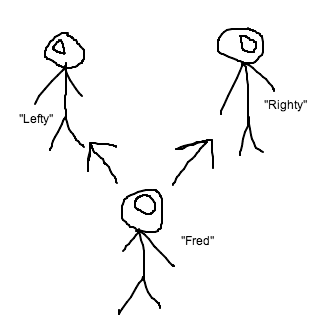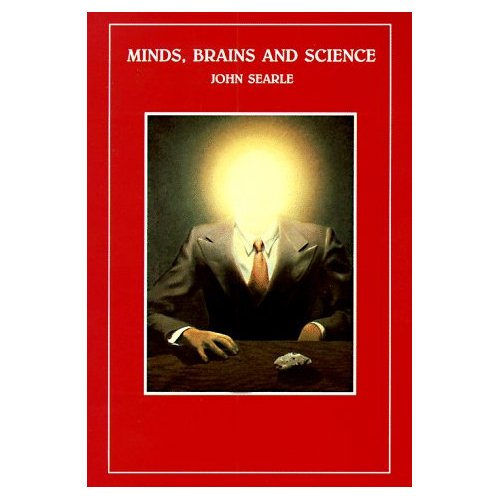When it comes to personal identity, the following question needs answering: what does it take for person A at time 1 to be the very same person as person B at time 2? Perhaps more clearly, right now I am sitting in front of my laptop, typing this post. In, say, ten minutes, there will be a person sitting in front of this laptop, publishing this post. What has to be true of that person for us to say that that person, ten minutes from now, is me? Now, it seems to me that this is a rather strange question for us to be asking, and it may be that we are simply confusing ourselves when we ask it—but let us assume for the present discussion that it is a coherent question to ask, as many contemporary philosophers certainly have, so that we may examine one answer that has been suggested.
The brain view, a slightly more refined version of the body view, says that in order for us to determine whether or not we have the same person at two different time points, we need to determine whether or not they have the same brain (accordingly, the body view says that we need to track the body—but this, for obvious reasons, can lead us astray). Neuroscience tells us quite assuredly that the brain is, in some way, the seat of what makes a person a person. Inside the brain lies all of the machinery required for memory, learning, personality, and all of the other traits and abilities that ordinarily allow us to identify the people around us as being who we think they are. The problem, however, with simply examining these surface-level features is that they can be mimicked, they can be replicated in a copy, leading us to the false conclusion that the copy is the real thing, just as if we were merely to examine outward body features. If we track the causal history of the brain itself, however, we should be able to figure out who is who in a more concrete manner.
So far, so good. We have what seems to be a good thesis: track the brain, track the person. Now we would like to refine the view even further. Is the whole brain necessary for personal identity, or only part of it? We know that in many respects the brain is redundant, having two more-or-less copies of each cortical structure—might we only need half of a brain to maintain personal identity? We are not necessarily constrained by specifics here, so let us make a simplifying assumption: each cortical hemisphere is indeed an exact mirror image of the opposite cortical hemisphere (there seems to be nothing in nature that points to this being impossible).
Now consider the following thought experiments: At time 1, Fred is a normal, healthy person. At time 2, he suffers a sudden, catastrophic loss of one of his cortical hemispheres. We now need to ask ourselves, is Fred-2 the same person as Fred-1? Common sense seems to tell us that he is, so perhaps on the brain view one hemisphere is indeed sufficient for maintaining personal identity. Now let us start over: at time 2, instead of Fred simply losing half of his brain, imagine that, instead, his brain is removed from his body, half of it is destroyed, and then the remaining half is implanted into the brainless body of Steve. After sufficient recovery from the operation, Steve’s body wakes back up—but who has woken up? On the brain view from before, we would have to say that Fred wakes up in Steve’s body. After all, it is the brain, not the body, that truly matters here. Alright, one more twist. Imagine this time that at time 2, Fred’s brain is again removed from his body, but this time the left half of brain is implanted into one brainless body, while the right half is now implanted into a separate brainless body. I have provided a schematic below to clarify the situation:
We have one body, Lefty, and another body, Righty (the names merely allow us to keep track of which body gets which half of the brain). After sufficient time for recovery, both bodies awaken. Now we again have to ask: who is waking up in each body? We have three options here, it would seem: 1) Fred, the same Fred as Fred-1, is waking up in both bodies; 2) Lefty is Fred-1, but Righty is not (or vice-versa); or 3) Neither of these people who wake up are Fred-1, Fred-1 died when the transplant took place. It we remain faithful to our previous conclusions, it would seem that we have to go with choice 1: both Lefty and Righty are equally Fred-1. But this can’t possibly be the case! How can Fred be in two spatial locations at the same time? Is he experiencing both bodies’ perceptions at the same time? If so, how? This simply seems to be impossible, and I am inclined to agree with this. Okay, how about option two? Perhaps Fred-1 is now in Lefty’s body—but wait, what reason do we have for him being in Lefty’s body versus Righty’s body? Both bodies, as per our simplifying assumption, have exactly the same half of a brain as the other. So much for option two. We’re now left with a final choice: neither Lefty nor Righty are Fred-1. Fred-1 is dead, no longer in existence.
But if we accept this conclusion, and it seems that we must, what does this say for our first two cases? Is Fred-2 no longer Fred-1 simply because he has lost half of his brain? There’s something that tells us that he has to be the same person. Obviously he is not exactly the same, he now has half of a brain, but intuitions seems to maintain that he is nonetheless still the same person—are we wrong?
I am not sure where exactly I stand on this issue at the moment, but I do have one thought that I think is promising. If the brain is truly duplicated in each hemisphere, but only one is needed for personhood, might there have been two people in Fred-1’s body (that is, one per hemisphere)? We may want to redefine a “person” as two of these “hemisphere-persons” in this case, which leaves us with the following: Fred-1 did not die, but half of him did. Fred-1, in the strictest sense, no longer exists, but part of him does. Returning to the final case, then, none of our original options really suffice. Instead, we would say that half of Fred-1 is in Lefty, while half of Fred-1 is in Righty.
This may not seem to be too strange of a conclusion, seeing that each body indeed has half of a brain, but when it comes to identity, it is at least a little weird. We like to think of personal identity as a 1:1 relation. You either have a person or you don’t, nothing in between. It’s not the case that after ten years of life, I am only 80% me. No, I am still me—the same person as I was before, even if my desires, beliefs, etc. have changed a little or a lot in the intervening time period. Should we re-evaluate this intuitive answer?

